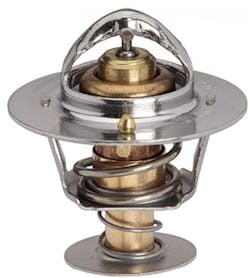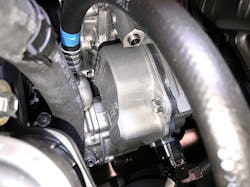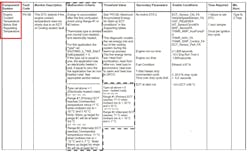How to work on computerized cooling systems in vehicles
Content brought to you by Motor Age. To subscribe click here.
My technician days began about the time that solid-state electronics were becoming commonplace in the automotive world. Dan Sublette, a former co-worker and mentor of mine at DE (Delco Electronics) passed down to me the story of the unofficial nickname for the first General Motors engine controller in the early 1980s. “ED” (for Electronic Device) predated the final title for the first engine control modules, or ECMs.
As technicians began diagnosing these new computerized engine management systems, they added the “F” for frustrating along with “R” for ridiculous. Thus, the nickname “FRED” was born. Forty years later, working on vehicles with FREDs is often frustrating, and the complex technologies can seem just as ridiculous. With some practical explanations and a real-world case study, this article will help lower your service bay frustrations and dispel the notion of ridiculous complexity on computer-controlled cooling systems.
Besides cooling fan operation (both electric fans and electro-viscous clutch fans) how does FRED help cool the heads (and engine block)? Mapped (electrically heated) thermostats, electric water pumps, and thermostat monitors all come to mind when it comes to FRED cooling the engine.
Master conventional thermostats first
Non-mapped thermostats are not just a wax pellet that expands and moves a valve when heated by engine coolant. Thermostats are more technical than you might think. Coolant must not flow into the radiator, past a closed (cold) thermostat. Therefore, the seal must be in good condition and have the correct mechanical fit to achieve that goal (Figure 1).
In addition, the coolant must have a path to flow around the thermostat. Depending on the application, some thermostats have a second valve and spring, called a bypass valve (Figure 2). Even when the thermostat is cold/closed, there must be a passageway, or bypass valve subsection in the thermostat to maintain a flow of coolant around the thermostat. Otherwise, the thermostat is simply reacting to stagnant coolant that does not accurately represent the temperature of the coolant flowing through the block and heads. If you notice a tiny brass “pin” in the top of the thermostat, it’s called a “jiggle pin.” This wobbly little pin/valve is a variation of the simple hole in the top of a thermostat that allows air to purge out of the engine and into the radiator.
Mapped thermostats
Powertrain engineers determine that "sweet spot" of coolant temperature that balances emissions and performance requirements. If the coolant (and cylinder walls/heads) run too cold, emissions and driveability suffer. If the engine runs too hot, excessive NOx (from spark knock) and even engine damage can result. If you need a cooler engine for just a few seconds of WOT, without "ping," it would be nice to have a thermostat with a lower opening point keeping the engine running cooler. For other driving parameters, the hotter temps can be advantageous.
Using a heater element that assists in opening the thermostat, we can bring the coolant temp down by as much as 50 degrees F in as little as two seconds (Figure 3). These electrically assisted thermostats get their title “mapped thermostats” from the sophisticated computer “software mapping” associated with the details on when the thermostat’s heater element should have power applied, to fine-tune the cooling system's temperature (Figure 4).
Two tech tips:
•Mapped thermostat or thermostat housing, with ECT sensor?Some conventional thermostats (non-mapped) integrated into a thermostat housing, may have an ECT sensor built into its housing. Most mapped thermostats are also built into a thermostat housing, with a two-wire connector for the heating element (Figure 5).
How do you tell one from the other (quickly)? Identify with an ohmmeter. The thermostat housing with the ECT sensor will have several thousand ohms of resistance (ignition off/cold engine). Mapped thermostats will only have a few ohms of resistance to draw current and heat up.
•Alternative thermostat testing
Forget the time-honored (and time-consuming) method of boiling water on the stove (or hot plate). The newer mapped thermostats, and many late-model conventional thermostats, run at high opening points. Many modern engine thermostats run over 220 degrees F. You will not be able to get water in a pan on the stove to achieve levels much over 212 degrees F (as water boils 212 degrees F at sea level when not pressurized by a radiator cap).
I've even run power and ground wires to a mapped thermostat’s heater element while the thermostat was immersed in boiling water. The thermostat’s valve still didn’t budge. The preferred test method for today’s thermostats is the on-car method Motor Age’s Pete Meier demonstrates in his “Trainer # 91” episode on YouTube. He demonstrates thermostat testing on the vehicle with a scan tool and a multimeter’s thermocouple probe, as well as an infrared, non-contact thermometer measuring the temperature of the radiator hose. Use a bidirectional scan tool (or jumper leads) to activate the heater element, on mapped thermostats, and add an even higher level of testing, to Meier’s on-car thermostat testing method.
Electric water pumps
Aisin began producing electric engine coolant water pumps for the GEN III Toyota Prius in 2010. With a DC-DC converter instead of an alternator, electric power steering, and an electric A/C compressor, a serpentine belt was no longer required on the engine. This electric water pump wasn’t reserved just for the hybrids, however. Toyota moved the technology to its D4-S engines on non-electrified models (Figure 6). Several other OEMs have also begun using electric water pumps in recent years.
On Toyota models, the circuit board internal to the Aisin electric water pump is complex-looking. One would naturally assume this means there's a three-phase BLDC (brushless DC) motor driver (Figure 7). That makes sense, as brushless motors are more reliable and use less current than conventional, 12V brushed motors. The good news for techs is we only have to diagnose the power, ground, and ECM control circuits, unlike some three-phase BLDC motors that have remote driver modules.
Thinking about current-ramping three-phase motors that have integrated driver modules? You can’t get your amp clamp around the individual phases as you can with many three-phase BLDC fuel pumps with external drivers. So, you’ll see a familiar "ripple" pattern on the power feeds to these pumps. Those “ripples” are not from the brush to commutator bar fluctuations (there are no brushes)! What you’ll be scoping is the fluctuation of the current draw as the internal motor driver creates each of the three phases to run these pumps. Electric cooling fans, blower motors, and EPS motors (with integrated three-phase BLDC motor driver modules) have similar patterns.
Bringing us back into the everyday service bay, here’s a case study on a Chevy Ecotec cooling system, with a mechanically driven water pump (and a non-mapped thermostat) setting stubborn P0128 “Thermostat performance” DTCs.
Case study vehicle – 2012 Equinox 2.4L
Pre-repair complaint - none
The vehicle (2012 Chevy Equinox) belonged to Mike, a very sharp master technician I’ve known and respected for many years. His vehicle was approaching 250,000 on the odometer when he decided to do some "preemptive" repairs. When your labor is free, and your parts come discounted, it's tempting to tell yourself "I'll decide when the XYX part on my high miler vehicle gets replaced.” We all detest roadside breakdowns, especially when it’s our family’s ride! Mike decided to address his Chevy Ecotec's high-mileage cooling system by replacing this list of new parts.
(PM / Preemptive repair parts)
- Water pump (had a slow leak that prompted the job)
- Radiator (and pressure cap)
- Heater core
- Both radiator hoses and all heater hoses, along with new hose clamps
- Cooling system flush thermostat
(Post-repair additional parts)
- ECT sensor
- ECT pigtail harness
- Second thermostat
Mike had worked at a GM dealership for a long stretch of his career. Being a believer in quality OEM parts, he purchased all his parts from the local Chevrolet dealership for this job.
Post repair complaint – P0128
The vehicle did not have a P0128 (thermostat performance) DTC before the PM work, but it did have that DTC about two weeks after the work was performed. Mike checked the most obvious cause for a P0128 (cooling system level), but it was full. A pressure test confirmed there were no leaks. He then observed the vehicle’s engine coolant temp gauge (comparing it to his scan tool’s ECT PID), and the two were pretty close to each other.
Next came engine warmup cycles to document the coolant temperature changes. It reached 150 degrees F within 10 minutes of startup. Then, it reached 195 degrees F after 20 minutes of driving. The highest temp Mike documented was 220 degrees F, just before the cooling fan turned on to bring the temperature back down. In Mike's experience with these engines, this seemed normal. Mike had used an AirLift to do the coolant refill, so he ruled out the possibility of an air pocket.
Next, Mike decided to try another OEM replacement thermostat. We all know from experience there are rare occasions where a replacement part “seems to work flawlessly,” but still manages to set a finicky (FRED) DTC. But really, it's a simple thermostat! How technical can it be? It either fits the application (mechanically), and opens at the specified temperature, or it doesn’t, right?
OEM thermostat number two: same DTC after the thermostat monitor ran twice. Mike next turns to analyze what makes these P0128 thermostat performance DTCs tick. In this case, GM describes their P0128 as Engine Coolant Temperature Below Stat Regulating Temperature (Figure 8). The same Malfunction Criteria chart is used for both heated (AKA "mapped thermostats") and non-heated (conventional) thermostats. Mike's 2012 2.4 Ecotec used a non-heated thermostat.
The chart gives the P0128 monitor a description of “This DTC detects if the engine coolant temperature rises too slowly due to an ECT or cooling system fault.” Rises too slowly...? That part of the statement involves “time,” not just “temperature.” One thing about this chart does appear obvious: FRED is watching his stopwatch and the ECT (along with the ambient temp) very closely, as the engine warms up. If the engine doesn’t warm up enough, within the correct period, a P0128 may be set.
What can delay engine warmup? Lots of things. A thermostat that opens too quickly would be at the top of the list, so Mike was wise in trying another replacement thermostat. Since software dictates FRED's regimented "to-do list," it would be reasonable to at least explore the possibility of a software update to address the problem, especially given GM’s history in making software improvements to enhance system diagnostics. That’s about the time I became involved to help a little.
I was teaching an evening technical class in the area where Mike lives. After class, we discussed his post-repair P0128 DTC. He was leaning toward trying an ECM calibration update. GM’s calibration updates are often found in TSBs or PIs (Preliminary Information) bulletins. If by some chance you don’t find an update there, don’t stop looking! Do a “Google” web search for “GM CAL ID” (https://tis2web.service.gm.com/tis2web/) and enter the VIN into the correct field. If you've flashed GM vehicles before, you know exactly to what I'm referring. If you haven't, I noticed a YouTube "how-to video" coming up in the Google search engine (right under the actual GM URL) in the search list. It’s 11 minutes of GM CAL ID website utilization tips worth watching, thanks to Cody’s Auto Diagnostics & Programming.
I looked over the calibration update notes myself, and sure enough, there was a note in one of the software subsections (engine diagnostics) that read, "New calibration increases the robustness of environmental temperature model" (Figure 9). We agreed that the words “robustness” and “environmental” did not exactly scream “P0128 fix,” but the words “temperature model” did give some hope.
Reflash didn’t fix the P0128
I went on my way after the late-night training class parking lot reflash, and Mike went back to the drawing board with his P0128 thermostat performance DTC. Curiosity regarding the cause of this DTC was now bugging me, so I looked to the Diagnostic Network (technician forum) for clues, and I saw Mike’s post with dozens of suggestions from other techs. Here’s the link if you’re a DN member. https://diag.net/msg/m5bbwmip7x0c108efpwhdggdx7
The DN family of techs was fantastic with numerous, well-thought-out suggestions in the long string. Their most repeated suggestion was to use a Stant (brand) thermostat. Mike tried a Stant brand thermostat, cleared the P0128, and the code never returned. This is not a negative comment on one brand or part of a sales pitch for another. On rare occasions, however, you may just need to try another brand of the part.
The ACDelco thermostat opened and closed as expected. The fact that the vehicle had good heater performance and was not overheating, was proof the thermostat was working. But there must have been a very minor difference in the "rate of opening" that resulted in setting this finicky DTC. I must also credit Curtis Hibbs, who did an excellent summary in the ALLDATA Community Repair Questions forum. He covered some GM PI’s, the thermostat brand factor, and the ECT sensor connections/pigtail issue that Mike addressed with his Equinox. The positive outcome of this case study illustrates the point that you can never have too many information sources, or too many friends, when figuring out FREDs.
About the Author
Dave Hobbs
Dave Hobbs is a senior technical trainer and curriculum developer for Delphi Technologies Aftermarket at BorgWarner Inc. He's Master ASE-certified with L1 (advanced engine performance) & L3 (hybrid) specialist certifications.
He has extensive OEM service and field engineering expertise, with more than 30 years of experience in troubleshooting vehicle systems electronics, with 15 of those years in the independent aftermarket repair business. He has 20 years of experience in training engineers (worldwide) and service technicians in both the OEM and aftermarket arenas, as well as experience in working with postsecondary vocational / community college students as an adjunct instructor.










